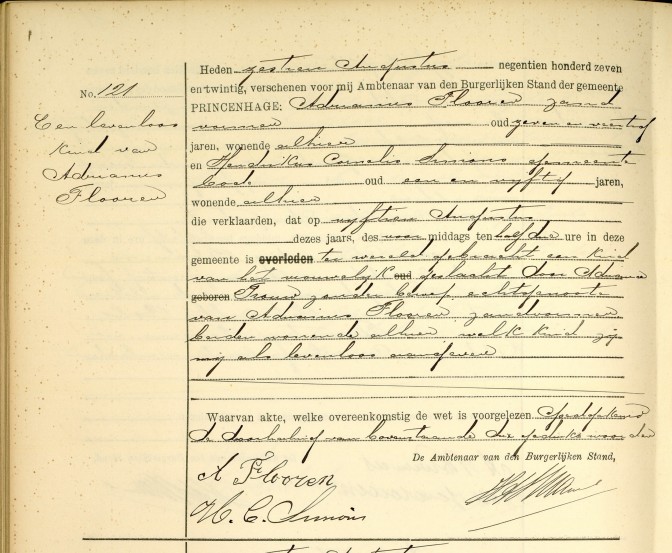Levenloos literally means “lifeless” and is used to refer to stillborn children. In death records, you will often read “levenloze dochter” [stillborn daughter], “levenloze zoon” [stillborn son] or “levenloos kind” [stillborn child].
Since 1811, death records were created for stillborn children (children born after a pregnancy of more than six months). They did not have birth records, as these were reserved for children that were born alive. If a child died before the birth record was created, a birth record was still created, as well as a death record. Before 1811, it is rare to find records for stillborn children.



Oh my gosh. I am so glad you posted this. I really thought that was a name!
Good to hear these articles are helpful 🙂
SInce I discovered WieWasWie and you announced when the English version was available (thanks!) I have lived on Goggle Translate. I keep a second tab open in my browser for Google Translate and cut/paste words/terms/phrases from WieWasWIe to it all the time, it really helps in the understanding of these records.
Great tip, I’m sure a lot of other people will find that useful too. Mind if I borrow it for a ‘quick tip’?
Feel free. I’ve certainly gotten more off this site than I could ever give! Thanks.
Concerning: Adrianus Flooren,
This certificate concerning a female child, daughter with surname Flooren, she could also have been born alive. Because registration exactly in the same words was used for children born alive as well as stillborn children.
“Levenloos” – only means not alive when the registration was made in the Netherlands before 1995.
In 1986 it became possible to give the child given names as well if the parent(s) wanted that.
Since 1795 birthcertificates were used and later in 19th century the registration changed using deathcerticificates – simply because it saved a lot of paperwork. And necessary because a deathcertificate meant official permission for burial – later burial or cremation.
The registration “Levenloos” before 1995 in the Netherlands, only means that the civil servant registered that he was told the child was not alive (anymore). Nobody cared if the child was stillborn or born alive before 1995 in such certificates. Therefore sometimes you do read words like “Doodgeboren” = “stillborn” or “Levenloos geboren” = “Stillborn”.
In this certificate is quite clearly NOT mentioned that the child is or was dead when born! Even if you cannot read Dutch words, it’s very clear that this child’s registration concerns the birth and not the death at the time of birth, that’s what it’s all about.